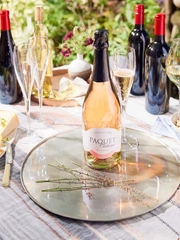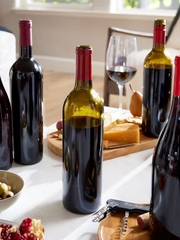Shears and saws are actively used in the vineyard around this time of year. This is truly pruning time in the Napa Valley. This special time of year creates beautiful scenes filled with fantastic fields of color.
Cover crops used by our winegrowers provide wonderful, colorful blankets that Monet, Van Gogh or Renoir would certainly envy.
While the vineyard manager can choose from scores of different choices for cover-cropping, some vineyards just go with a “volunteer” cover crop, one that naturally grows when winter begins and water is abundant. One of the most widely used volunteer cover crops in wine country is the mustard plant.
There is no need to replant mustard. Each plant produces an enormous quantity of mustard seeds, so much so that if one were to remove the plants that grow each year before they seed, it is likely that around 40 years’ worth of seeds are in the ground, just waiting for their chance to grow.
The Benefits of Cover Crops
Of course, the natural and artificial beauty of fields and vineyards are not the primary concern. Around the world, cultivating certain types of plants in between crops is not new. There may be a tendency to think of a vineyard as a monoculture: a field where only one plant is grown, but this is typically not the case. More often than not, cover crop seeds are intentionally planted to grow at this time of year, which raise and maintain the quality of soil with Nitrogen, Phosphorus and Potassium (NPK). If it works for the farms of Iowa, Texas, Tennessee or Kansas, it certainly works for grape growing. This green approach of no-till operations prevents soil erosion and encourages root growth.
Good viticulture employs the planting and growth of many other crops for a variety of purposes. Vines produce better grapes when the soil is well maintained. Cover crops help with drainage by counteracting excess moisture. Cover crops can also provide an essential habitat for beneficial insects that keep the population of harmful insects down and many plant diseases in check.
The Types of Plants Used for Cover Crops
Cover crops are chosen and planted for the specific benefits they bring to an individual vineyard. These plants can include legumes such as fava beans and bell beans or clover, all of which benefit from a symbiotic relationship with Nitrogen-fixing bacteria. When the plants are tilled into the soil, they decompose and deliver Nitrogen in a usable form to the grapevines.


Grains, such as rye grasses or oats, are also commonly planted. These mainly carbon-containing plants benefit the vineyard by increasing soil tilth, or structure/looseness and aeration. Often a blend of grains and legumes is employed to get the benefits from both properties.
Vineyard cover crops also draw down the abundant moisture in the soil resulting from heavy winter rains. High-quality grapes require restricted access to water during the time between bloom and veraison (the onset of ripening). In California, we receive nearly all of our annual precipitation between the months of November and May, and cover crops can help use up some of that water.


A final and extremely important reason for cover crops involves the flowers they produce. Many beneficial insects are attracted to flowers. These insects are important for vine health, as they prevent invasive species like mites, mealybugs and other insects that are damaging to the grapes. Plants that are especially good at attracting beneficial insects are buckwheat, alyssum and crimson clover.
The mustard from the Napa Valley might not be as famous as the condiment from Dijon, France; but the presence of mustard in our valley’s vineyards at this time of the year is a gauge of health and prosperity for our grape growers.

 Grains, such as rye grasses or oats, are also commonly planted. These mainly carbon-containing plants benefit the vineyard by increasing soil tilth, or structure/looseness and aeration. Often a blend of grains and legumes is employed to get the benefits from both properties.
Vineyard cover crops also draw down the abundant moisture in the soil resulting from heavy winter rains. High-quality grapes require restricted access to water during the time between bloom and veraison (the onset of ripening). In California, we receive nearly all of our annual precipitation between the months of November and May, and cover crops can help use up some of that water.
Grains, such as rye grasses or oats, are also commonly planted. These mainly carbon-containing plants benefit the vineyard by increasing soil tilth, or structure/looseness and aeration. Often a blend of grains and legumes is employed to get the benefits from both properties.
Vineyard cover crops also draw down the abundant moisture in the soil resulting from heavy winter rains. High-quality grapes require restricted access to water during the time between bloom and veraison (the onset of ripening). In California, we receive nearly all of our annual precipitation between the months of November and May, and cover crops can help use up some of that water.

 A final and extremely important reason for cover crops involves the flowers they produce. Many beneficial insects are attracted to flowers. These insects are important for vine health, as they prevent invasive species like mites, mealybugs and other insects that are damaging to the grapes. Plants that are especially good at attracting beneficial insects are buckwheat, alyssum and crimson clover.
The mustard from the Napa Valley might not be as famous as the condiment from Dijon, France; but the presence of mustard in our valley’s vineyards at this time of the year is a gauge of health and prosperity for our grape growers.
A final and extremely important reason for cover crops involves the flowers they produce. Many beneficial insects are attracted to flowers. These insects are important for vine health, as they prevent invasive species like mites, mealybugs and other insects that are damaging to the grapes. Plants that are especially good at attracting beneficial insects are buckwheat, alyssum and crimson clover.
The mustard from the Napa Valley might not be as famous as the condiment from Dijon, France; but the presence of mustard in our valley’s vineyards at this time of the year is a gauge of health and prosperity for our grape growers.





